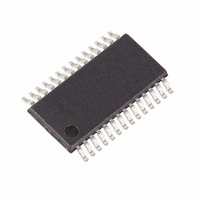MAXQ3181-RAN+ Maxim Integrated Products, MAXQ3181-RAN+ Datasheet - Page 59

MAXQ3181-RAN+
Manufacturer Part Number
MAXQ3181-RAN+
Description
IC AFE POLYPHASE LO-PWR 28-TSSOP
Manufacturer
Maxim Integrated Products
Datasheet
1.MAXQ3181-RAN.pdf
(84 pages)
Specifications of MAXQ3181-RAN+
Number Of Channels
8
Power (watts)
35mW
Voltage - Supply, Analog
3.3V
Voltage - Supply, Digital
3.3V
Package / Case
28-TSSOP
Lead Free Status / RoHS Status
Lead free / RoHS Compliant
Number Of Bits
-
• Read the meter quantity again to verify the calibra-
Note that these steps can occur more than once for a
given signal type to verify readings at different signal
levels.
There are two methods to read the meter in the above
second step. The first is to read the raw register associ-
ated with the value under calibration, for example,
A.VRMS for the phase A voltage channel; A.IRMS for
the phase A current channel, and A.ACT for phase A
real power.
The second calibration method assigns a pulse output
to the value being calibrated and measures the pulse
period. In practical use, the method chosen depends
on the specific application and the available equip-
ment. For example, in some applications the voltage
and current are of no concern, but the energy accumu-
lation must be very accurate. For these applications,
meter calibration sets with built-in pulse measurement
facilities can make the most sense.
The calibration procedure involves the following gener-
al steps:
• Calibrate voltage for a given phase by applying a
• Calibrate current by applying a known current and
• Once the current gain and voltage gain are calibrat-
• Calibrate the phase offset by applying a power factor
Once these elements are calibrated for each phase, all
other information (power factor, apparent power, etc.) is
tion.
known voltage and adjusting the voltage gain
(A.V_GAIN for phase A) until the RMS voltage
(A.VRMS for phase A) reads the applied voltage in
the designated units.
adjusting the current gain (A.I_GAIN for phase A)
until the RMS current (A.IRMS for phase A) reads the
applied current in the designated units. If desired,
the current can be calibrated at two points (low
range and high range) for more accuracy.
ed, the power/energy should not require any addi-
tional adjustment for most situations. Although, a
separate power gain register is available for further
fine-tuning of the power/energy accuracy. One must
keep in mind that anytime voltage or current is recali-
brated, the power or energy accuracy is naturally
affected. So the power gain should be recalibrated to
achieve the desired accumulative effect of voltage,
current, and power gains.
load and adjusting the phase angle offset according-
ly. If desired, the phase offset can be calibrated at
up to three points for more accuracy.
Low-Power, Active Energy, Polyphase AFE
______________________________________________________________________________________
also properly calibrated. The descriptions in the follow-
ing sections deal specifically with phase A, but the
same procedure is followed with phases B and C.
Ensure that there is no previous value in the gain regis-
ter, A.V_GAIN, by setting this register to 0x4000.
• Apply a known voltage with RMS value close to the
• Read the A.VRMS register. Note the value.
• Convert the known value to meter units by dividing it
• Divide the applied value (in meter unit) by the value
• Multiply the calculated value by 2
When the gain value is programmed, wait for 2 to 3
seconds, reread the RMS value from A.VRMS. Check
that the measured value is correct by comparing
A.VRMS against the applied voltage in meter unit.
Voltage Calibration Example
Assumptions: V
VRMS.
• Convert the applied voltage to meter units. This cal-
• Read the A.VRMS register. You read 0x0708029.
• Divide the applied voltage by the voltage read from
• Convert to integer by multiplying 2
Ensure that there is no previous value in the gain regis-
ter, A.I_GAIN, by setting this register to 0x4000.
• Apply a known current with RMS value close to the
• Read the A.IRMS register. Note the value.
• Convert the known value to meter units by dividing it
desired maximum operating voltage (and less than
V
by MU_VOLT (= V
read from the MAXQ3181. The result should be a
value between 0 and 2. If the value falls outside of
this range, you have probably miscalculated V
gain value to be programmed into A.V_GAIN. Ensure
the most significant bit is 0.
culation gives 240 x 2
0x006E1679.
This is 7,372,841 decimal.
the meter. The result is 7,214,714/7,372,841 =
0.97855.
0.97855 = 16,033 = 0x3EA1. Write this value to the
A.V_GAIN register.
desired maximum operating current (and much lower
than I
by MU_AMP (= I
FS
/√2).
FS
/√2).
FS
is 558.1V. The applied voltage is 240
FS
FS
/2
/2
24
24
).
).
24
Calibrating Voltage
Calibrating Current
/558.1 = 7,214,714 =
14
. The result is the
14
: 16,384 x
FS
.
59











